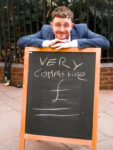The 2015 Tour de France cycle race starts in Utrecht, Netherlands, on 4 July.
Bradley Wiggins was Britain’s first ever winner of Le Tour. His prize, besides knighthoods and sponsorship deals, was to ring the bell that opened the London Olympics in 2012.
But do we only know Bradley because he was a ‘winner’?
In his 2014 book, Lanterne Rouge, Max Leonard researched all the losers of the Tour de France since it started, in 1903.
Whilst we award a yellow jersey to the rider at the front, we also ‘award’ a red lantern to the cyclist at the back.
But consider, if you will, that the ‘loser’ has to psychologically work harder, physically ride longer and by the time they eventually finish they will have endured a lot more than the ‘winner’.
In our teams, who are the yellow jerseys and who are the red lanterns?
Just as in a cycling peloton, the yellow jersey can help the red lantern by going up front and creating a slipstream in which to follow at reduced wind resistance, making cycling easier and more efficient. Yet any yellow jersey also relies on a team that can take over the lead rider position from time to time to allow chance for rest and renewal. Any individual glory is predicated on a team behind them.
Dave Brailsford, Team Sky principal, oversaw both Bradley Wiggins' and Chris Froome's victories in the 2012 and 2013 Tour de France. As performance director at British Cycling he developed the idea of 'marginal gains': “if you broke down everything you could think of that goes into riding a bike, and then improved it by 1%, you will get a significant increase when you put them all together.”
So as well as looking at traditional components of success such as physical fitness and tactics, Brailsford's approach adopted a more holistic strategy, embracing technological developments and also athlete psychology.
Over the century of Le Tour, the gap between the first and last placed rider has narrowed. In 1903 the last placed rider, Arsene Millochau, finished 64 hours, 57 minutes and 8 seconds behind the winner Maurice Garin. In 2014 Ji Cheng from China finished only 6 hours behind Italian cyclist Vincenzo Nibali.
The good news here are the improvements that Dave Brailsford’s philosophy can bring to all our teams. The warning though is that this increasing homogenisation of Le Tour mirrors increasing homogenisation inside companies. A narrower time gap is viewed as a good thing, but actually it just means we are all more alike. A few more Arsene Millocchaus would not necessarily be a bad thing.
The founder of the Tour de France, Henri Desgrange, said “the ideal Tour would be one in which a single rider succeeded in completing the challenge”. This model of leadership was set forth in 1903 but it still prevails too often in 2015. If we want to be successful we all have to be successful, and that requires a different approach to leadership.
So acknowledge the red lanterns in your team. They are an essential ingredient in our collective success.






